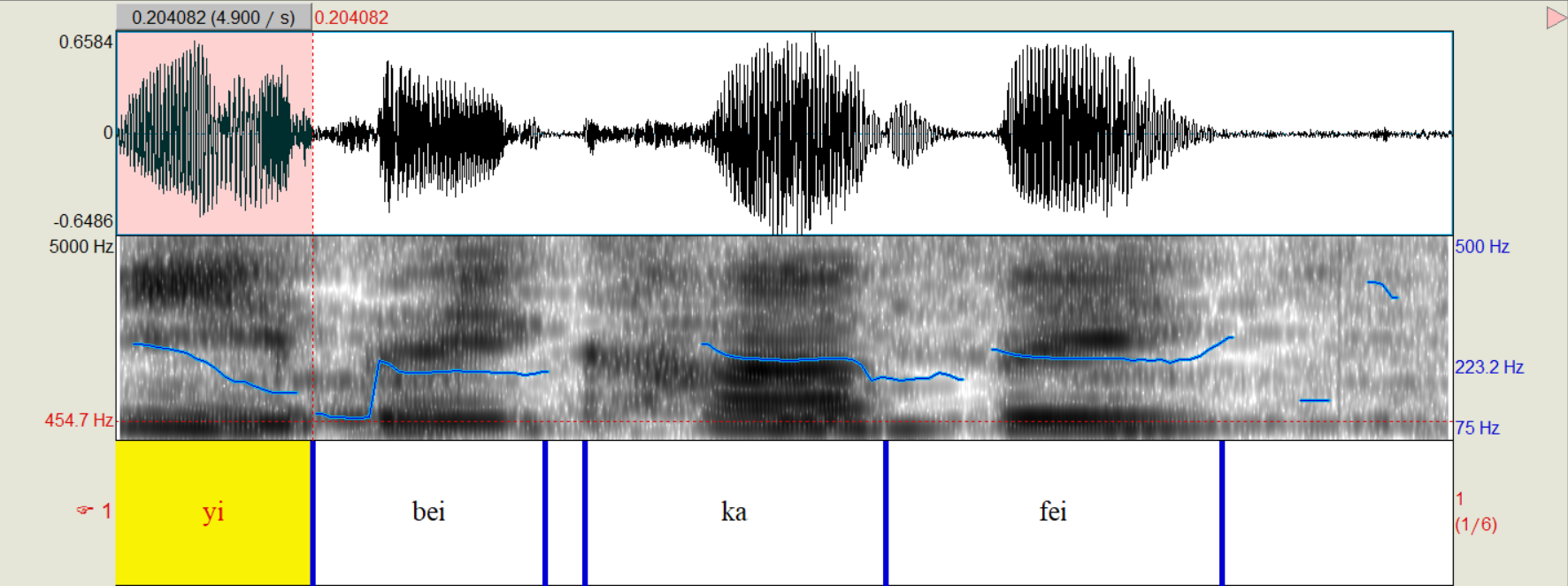Extract normalised pitch contour
• • Reading time: 3 minutes
Last updated:
On this page I present a Praat script that extracts pitch contour information based on .wav sounds and .Textgrid files.
This script is useful for analysing lexical tone, but can be also useful for other analyses where pitch contour is important, e.g. intonation.
Step 1: Preparation
Download the Praat script.
Gather your .wav files and your .Textgrid files in the same folder. The .Textgrid files should have the same name as the .wav files. The .Textgrid files should contain at least one interval tier, based on which pitch contour information should be extracted.
For example, I am extracting the pitch contour of each syllable in a Chinese phrase, for further lexical tone analyses. My .Textgrid should contain one interval tier, where each syllable should be a named interval.

Note: Inside your .Textgrid, you may want to choose to set the interval boundaries around the vowel (where pitch contour information is mostly carried), to better capture the pitch contour. Or you may want to set the interval boundaries around the entire syllable, like what I did with ka and fei in the example, to better represent the length of the syllable, although this will result in some ‘undefined’/NA values during some consonants.
Step 2: Run the script
Download and open Praat.
Select Praat - Open Praat script…, and select extract_pitch_contour.
If on Mac OS, replace the “" in line 55 with “/”.
Select Run - Run. You will be presented with a user interface, where you can specify a number of variables.
- General variables:
- Tier number: index of the tier of interest (where the intervals are defined).
- Sound file extensions: The extension of should files in your folder (e.g.: .wav)
- Result file name: name of the result file. Recommended extension
.csv - Normalise by: precision of sampling. For example, 10 means that Praat will extract pitch information at time 0%, 10%, 20%, …, 100% (10+1 data points in total); and 50 means that Praat will extract pitch information at times 0%, 2%, 4%, 6%, …, 100% (50+1 data points in total).
- Pitch parameters:
- Time steps: (Praat default: 0.0) the measurement interval (frame duration), in seconds. If you supply 0, Praat will use a time step of 0.75 / (pitch floor), e.g. 0.01 seconds if the pitch floor is 75 Hz; in this example, Praat computes 100 pitch values per second.
- Pitch floor: (Praat default: 75 Hz) candidates below this frequency will not be recruited. This parameter determines the length of the analysis window: it will be 3 longest periods long, i.e., if the pitch floor is 75 Hz, the window will be 3/75 = 0.04 seconds long.
- Pitch ceiling: (Praat default: 600 Hz) candidates above this frequency will be ignored.
Define the variables based on what you need, then select OK. Praat will start processing your files, and an output file summarising all pitch information extracted will be created in the same folder:

The file selection procedure used in this script is from Scott Seyfarth annotation.Praat.